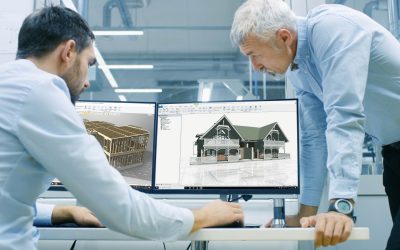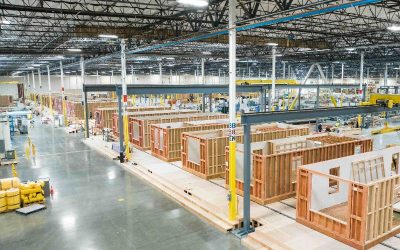BIM: Modernizing Building Lifecycle Management
Throughout our BIM blogging series, we’ve discussed the big-picture advantages Building Information Modeling software offers — improved communication, reduced costs, increased productivity, and safer construction sites.
The key to realizing those major benefits lies in the way BIM is integrated into each stage of a building’s lifespan.
- Blog Post
- September 2019
- Pekka Moilanen

In fact, BIM technology is the backbone of what’s known as Building Lifecycle Management — the integrated coordination, organization, and control of all the information that pertains to a building project. This information includes everything from the steps taken before the design is even created, to the construction process, to the building’s eventual renovation or demolition. That can be a lot of data collected over a large span of time, which requires accurate and extensive collaboration with BIM.
Let’s take a closer look at how using BIM software impacts each phase of Building Lifecycle Management.
Phase 1: PLAN
- During the planning phase, all architects and designers have access to the same digital models. This promotes coordination and communication between parties, so any issues or inconsistencies can be worked out before you even break ground.
- Project management strategies, scheduling, and budget information can be addressed during this phase with the help of the BIM data.
- Design options, such as material choices, can be compared by viewing them on the digital 3D model. For example, you could do a side-by-side comparison of two deck or roofing materials, allowing you to visualize how each would affect the appearance and feel of the finished project. This can potentially help with both cost control and long-term maintenance concerns.
- Information about who held responsibility for each element of the building design should be included in the BIM data during this phase, as well as up-to-date contact information for those individuals.
Phase 2: BUILD
- Changes to the structure that come up during the construction phase will be:
- Reduced significantly by planning and designing the structure using BIM software
- Automatically updated in the digital model so everyone involved in the project will be aware of the changes
- Because the details of the project — think scope, budget, and schedule — were coordinated during the planning phase and are updated as any tweaks are made, contractors can take advantage of Just-in-Time delivery. This means building materials will be delivered only when it’s time to install them, saving you money by eliminating the delivery of unnecessary items and keeping materials from being destroyed or stolen while they sit around on the job site.
- Similar to the planning phase, information about who is responsible for the work and completion of different parts of the building should be included here, as well as up-to-date contact information for those individuals.

Phase 3: USE
- When the building is complete and the commissioning process begins, the BIM data is transferred from the construction crew to the new facility management team.
- Important information about the configuration of the building’s interiors is included in the updated models. Details such as where cables and outlets are located may be included, as well as where offices/units are located, so the space can be used to its full potential by its occupants.
Phase 4: MAINTAIN
- All operation and maintenance (O&M) documents can be included in, or at least referenced from, the BIM model.
- Building maintenance that takes place — both planned and unexpected — is updated in the BIM file. Including this type of information allows the site management team to determine their own best practices for maintaining the structure. An added benefit: If the structure is part of a larger complex, the teams from the different buildings can share these best practices within the shared BIM information.
Phase 5: REPAIR and IMPROVE
- Whenever a repair or improvement is made to the building, it is noted or updated within the BIM model. This includes information about who completed the work, what was done and when, and where the update or repair was located within the building. If changes were made to the structure or function of the building, those alterations should be noted in the BIM software as well.
- If, down the road, it is discovered that part of the building was constructed in a way that does not meet local standards or codes, or if the building is not performing to its full potential, the current management team or occupants can refer to the BIM information to find who designed, approved, supervised, executed, and inspected the building at different stages. This allows for any disputes to be addressed with the appropriate contacts.
Phase 6: LEARN
- Because the BIM data is saved within the software, people can use that information to make informed decisions about the building over the course of its lifecycle. They can also use that information for constructing similar structures. All the information the model contains — in terms of building parts that needed to be replaced or repaired, modifications that were made to the building, or long-term maintenance options that have worked or not worked — will help create best practices for each structure and management team.
Phase 7: DECOMMISSION
- The decommission stage of a building’s lifecycle refers to when the structure is either dramatically updated or renovated, or demolished. Often, the decision to change or tear down is a difficult one to make, but it is made easier when you have the information at hand to complete a thorough A-to-Z analysis of the building. Having all this information stored in the BIM software makes coming to an educated decision much easier.
Working with BIM software from the onset of your project not only provides benefits during the design and construction phases of your build, but throughout the structure’s entire lifecycle. Having easy access to every piece of information about the building from start to finish is an invaluable long-term asset and one that can be achieved through the innovative technology of BIM software.
Related Stories
Best 3D construction software for professionals
Best 3D construction software for professionals 3D construction software has become a cornerstone of modern building projects, fundamentally transforming traditional construction practices. By enabling architects, engineers, and builders to create highly detailed,...
Leading construction design software for professionals
Leading construction design software for professionals In the ever-evolving construction industry, construction design software has become indispensable for streamlining workflows, enhancing accuracy, and improving collaboration. Among the available options, Vertex BD...
What is modular building design? – Unlock efficiency and precision
To fully unlock the potential of modular building design, it’s essential to utilize advanced tools that streamline the process from design to construction. While modular construction already offers significant advantages like faster timelines and cost savings, a tool like Vertex BD takes it further by integrating design and manufacturing into one seamless platform.




